Forum Replies Created
-
Mental Mondays #9 The yes, we know it’s Tuesday, edition
-
eshershoreFree MemberPosted 10 years ago
I owned many FS bikes and over several seasons swapped down from 200mm to 180mm to 160mm to 145mm to 100mm and eventually to a carbon fibre 29’er hardtail
this happened as my riding needs changed, and I just found the bigger bikes felt slow and unnecessary on the trails I was riding in the South-East of the UK.
the 29’er hardtail is much more fun to ride for me on these trails (where the FS would soak it all up) and its so much easier to clean and a general lack of maintenance
I am still going very quick, probably averaging quicker times than on the FS bikes
cannot see myself buying another FS bike unless I moved somewhere with rocks and lots of tree roots.
eshershoreFree MemberPosted 10 years agogot into road cycling in November 2012 when I started working at a bike store that was focused on road sales
before this I was heavily into mountain biking with a good number of years doing extreme freeride and racing DH, and BMX
finding the road cycling good fun as its a new world to me, even though I am not into the road “culture” itself
very much enjoy long distance solo riding (normally around 70-80 miles) and 1 hour all-out sessions climbing steep hills and fast descents
still riding the MTB, which I enjoy, but this is generally 1-2 times a week as a bit of a treat as it always seems like a much easier ride than my daily commute of 50km, or my regular road sessions
eshershoreFree MemberPosted 10 years agoI didn’t use a torque wrench until I started working for Evans Cycles some years back (I don’t work for them anymore)
I’ve used torque wrenches since, simply because it good practise to tighten bolts to the manufacturers’ recommended settings, it tends to prevent damage to components
When working for a large, commercial organisation like Evans, we would keep records of each bike built, and using torque wrenches was one aspect of preventing compensation vultures from enjoying easy returns on any liability claims
Personally? I will always use a torque wrench when working on a customer’s bike, or one of my own bikes at home.
It’s simply become an aspect of being a more professional bike mechanic, and any mechanic that tells you that they gauge torque using their “hands” is often wildly wrong or just deluded….
…this included professional mechanics working for international road bike teams which saw repeated component failures as mechanics were repeatedly “snugging up” bolts to ensure they were not loose, and were unknowingly over-tightening fittings and stretching the components until they failed.
eshershoreFree MemberPosted 10 years agoyup, I never degrease my chains, simply ruins them!
wipe and lube, wipe and lube
exactly what Shimano and more importantly KMC (2 million chains manufactured a DAY) recommend in their technical literature
never anything harsher than soapy water.
but of course, putting chains through parts washers or exposing to aggressive cleaning solvents accelerates wear and requires customers to replace drivetrain parts more frequently…shhhhh…perhaps I should not have let that slip ;)
eshershoreFree MemberPosted 10 years agoit happens…the loss in interest
happened to me a few years back, when I realized getting a new bike didn’t get me excited any more
currently work in the bike trade, commute 250km a week by road bike, and the last thing I am interested in on my time off..is bikes
only magazine I buy is film mag ‘Empire’, and I try to avoid bike shops and bike shows like the plague
still enjoy riding my bike (to work and back) but not the bike scene itself, could care less
eshershoreFree MemberPosted 10 years agoI’d suggest looking very carefully at the ‘warranty’ and real world example of ‘warranty claims’ (easily found on the internet, usually as complaints..) when choosing a “brand”
typically, the large brands with good distributors will offer timely warranty, the smaller brands with not-so-good distributors, not so…
eshershoreFree MemberPosted 10 years agodefinitely get a good set of torque wrenches with interchangeable bits
avoids this:
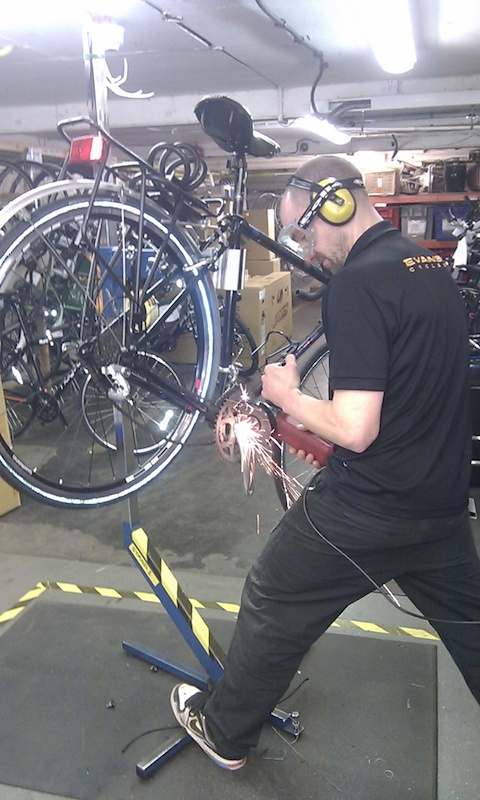
worth every penny
happy trails!
eshershoreFree MemberPosted 10 years agoalways spend good money on good quality tools – if not used in a professional environment then many of the current “brands” will last you a lifetime
at work (bike workshop) we use a mix of Park, Pedro’s, Knipex, Draper, Snap-on, etc.
its not worth buying ‘branded’ bike tools for generic tool pieces like ring spanners, allen keys, screwdrivers; you can get better quality tools for less or similar money from proper tool brands
here is a selection of some recent work benches I have setup:
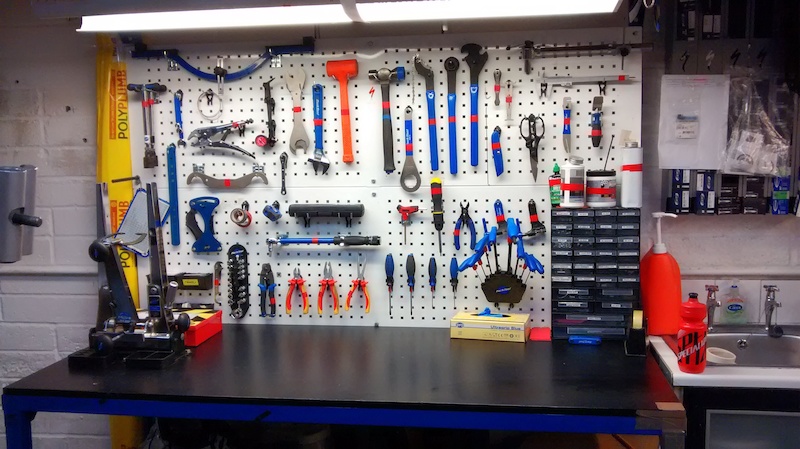
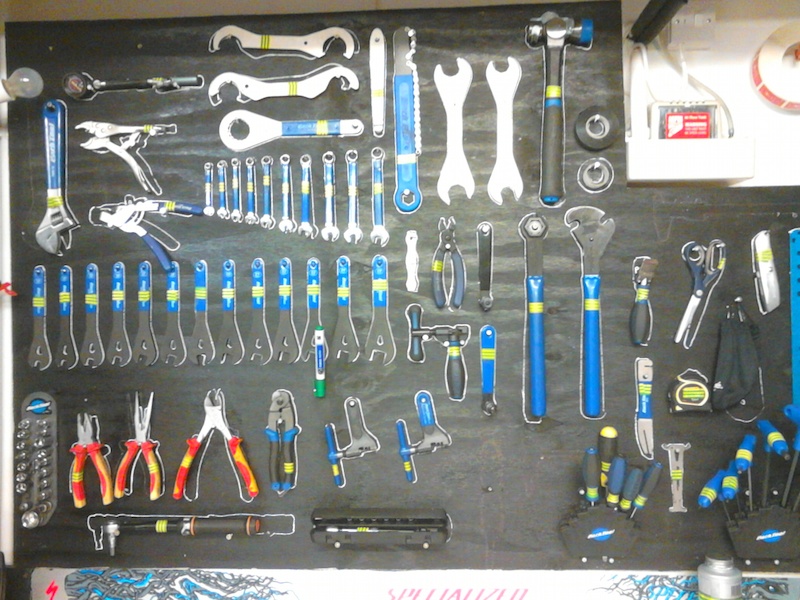
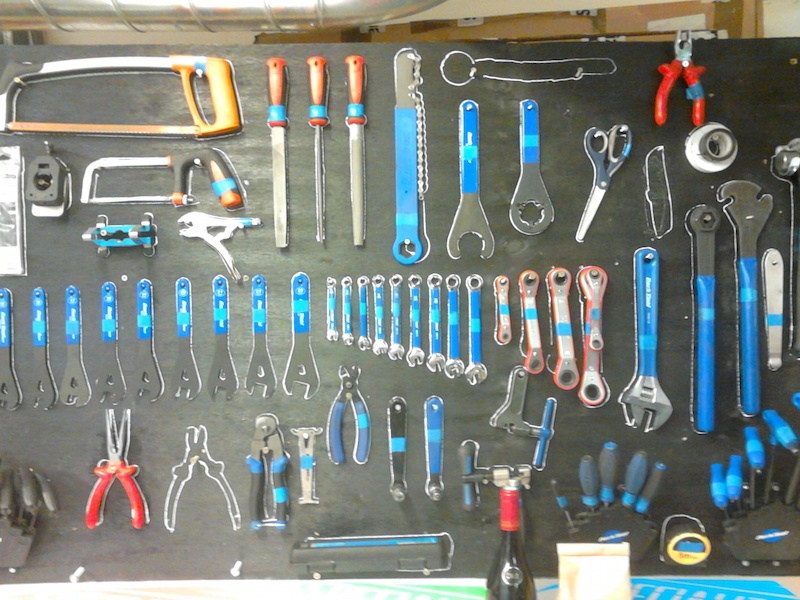
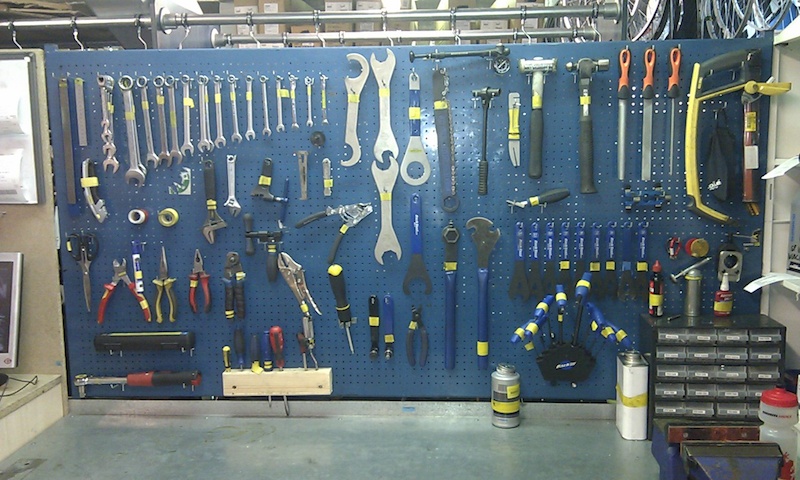


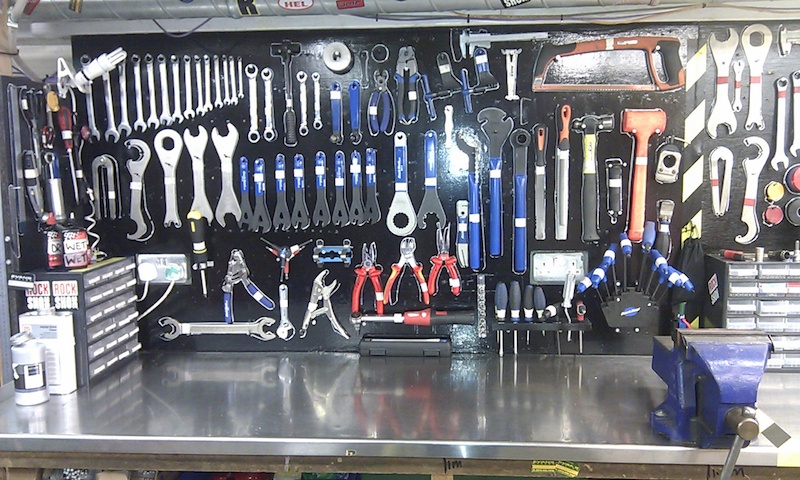 eshershoreFree MemberPosted 10 years ago
eshershoreFree MemberPosted 10 years agowhat can happen is when you install the pedal you allow the cromoly steel pedal axle to bite hard into the aluminium alloy crankarm (or insert for perhaps, the CF crank you mention)
this then chews into the insert, creates a binding ridge, and makes it hard to remove as you need to overcome this ridge to remove the pedal
try using the largest / longest tool you can create. if the pedal uses an allen key fitting, try using the wrong end of an adjustable spanner to leverage against the allen key. If the pedal needs a pedal spanner, get some tubing to slide over the pedal spanner end – I have used a metal vacuum cleaner extension tube in a pinch..but don’t tell my missus!
eshershoreFree MemberPosted 10 years agoSpecialized certainly have the “mid size” wheel coming out sooner than you think…Sea Otter Race in the USA is where we will see their popular trail and enduro bikes with this wheel size ;)
eshershoreFree MemberPosted 10 years agoits tricky expecting a retailer to stock every product in every size in store
yesterday I went into a Specialized Concept Store to buy some winter tights for road cycling
found some big gaps in their stock levels – could not get a popular “roubaix” winter tight in medium, because Evans and Cycle Surgery bought out Specialized UK’s stock on the first “drop” that landed, and smaller retailers (including many of these concept stores) were left without stock…
funny business, the bike industry! and I work in it…
eshershoreFree MemberPosted 10 years agodid you fit your pedals?
or someone in a bike shop?
its a question of leverage
if you use the same tool as was originally used, and apply the same force, it will release with no problem
using a different tool (smaller leverage) or using less force (if fitted in a shop, maybe the mechanic likes lifting weights and drinking Monster Energy at work!)
a good trick is to slip a long steel tube over the tool, to increase the effective torque without compromising your safety by placing too much load on a smaller tool
eshershoreFree MemberPosted 10 years agoRan specialised fast track 29 tires on mavic a319 rims, no problems!
eshershoreFree MemberPosted 10 years agoMy 1st pair of sam hills lasted 2 years until regular trail building split the soles
My 2nd pair of sam hills lasted 2 years until, again, trail building split the soles
Now got some carvers in blue/black, no trail building so will last longer..
eshershoreFree MemberPosted 10 years agobest suspension bike I owned for trail riding and all round hooligan action was my Devinci Dixon with the DW designed Split Pivot suspension, Fox RP23 with Fox air volume tuning kit.
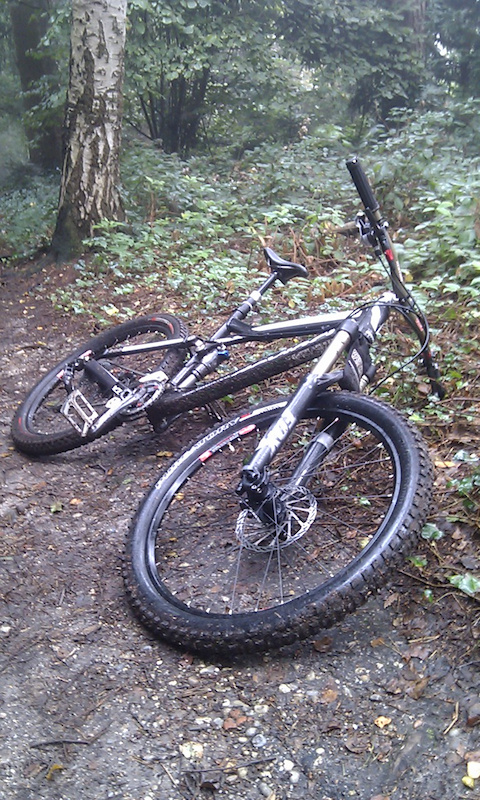
Have owned lots of VPP, simple single pivots and FSR / four-bar (horst pivot) and faux-bar bikes, probably 40+ suspension bikes in total.
The Dixon had the balance of a bike that could be hammered under power without bouncing or squatting (an issue with my FSR’s), whilst maintaining amazing traction on horrible terrain, especially when braking hard.
Don’t claim to understand the science, it just plain worked. Rarely touched the pro-pedal level on the RP23 shock, unlike on my FSR where is was constantly used to increase compression damping and make the bike somewhat pedallable
the other thing I really liked about the Dixon is that each pivot had the same (large) sealed bearing and sensible hard wearing axle pivot hardware, which meant it rarely required any looking after!
eshershoreFree MemberPosted 10 years agoNothing grip like 5 10 soles
Been using 5 10, Nike 6.0, vans, etnies, orchid, DC, airwalk, etc for years on mtb and bmx for years.
Not the same at all…
eshershoreFree MemberPosted 10 years agoNew olive and barb
Carefully remove mc fitting, hard tug on hose to remove.
Cut hose with quality cable cutter fit new barb and olive. I use split yellow shimano held in mole grips and tap barb to hose with ball end hammer.
Should not need to bleed unless you grab brake lever during process.
eshershoreFree MemberPosted 10 years agoWell here’s the rub…
You want commercial cutters like knipex to cut the cable inner and outer.
But to finish the inner cable end cap with a crimp at 40nm you need Park or similar as commercial wire cutters don’t have crimping function.
In my workshop we cut with knipex and crimp with park.
eshershoreFree MemberPosted 10 years agobeen riding Hope Pro III on Open Pro for 12 months
wheels were not well built from the “factory” (hope), spoke tension not well balanced and wheels not very true
thankfully, I am an experienced wheel builder, so removed tension, re-tensioned the spokes and trued using a Park spoke tension meter to get them correct
have been good as gold since, and I am not shy on abusing my road bike whether its smashing through potholes, getting air over sleeping policemen, going off-road on fire-roads from time to time, or just ragging it downhill
I have lots of experience with Stan’s rims, I used to work for the UK distributor and ran multiple sets of ZTR Flow rims on different bikes
in hindsight, I’d prefer eyeletted rims every time to the ZTR rims, mine all cracked around the spoke drillings, within a year of ownership (I built them all myself, using recommended spoke tension)
thing I like about the Mavic Open Pro’s is that they work, light enough, nice stiff rim with good square braking surface and cheap to replace using regular components if broken in a big crash or RTC
here’s mine:
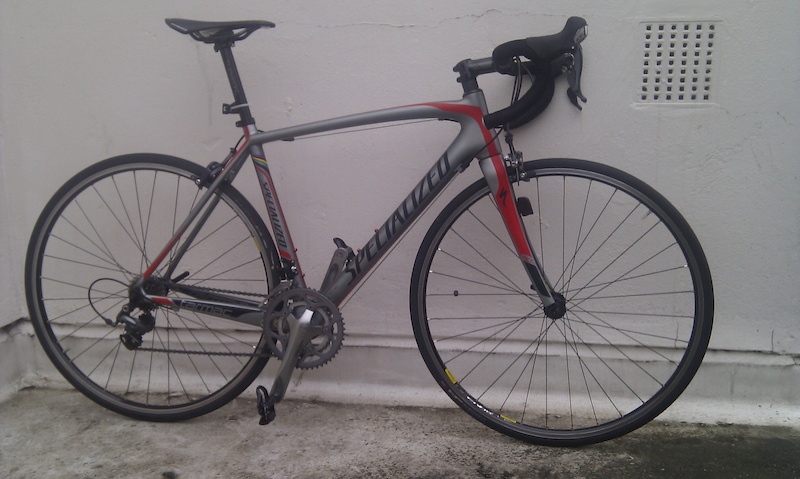 eshershoreFree MemberPosted 10 years ago
eshershoreFree MemberPosted 10 years agoGet the smallest bike that fits. It’s easy to resize a smaller bike, much more difficult to resize a bike too large as once stem drops below 90mm handling tends to suffer whether climbing or more interestingly descending where steering feels too sharp and front wheel too light.
On my 56 allez I used a Thompson in line seat post as this was only way to shorten reach but it screwed up my pedalling and caused hip/knee pain. With 54cm tarmac I moved to regular lay back post and got this sorted!
I played with 75 and 80mm stems on my 56 allez and 54cm tarmac and found them detrimental to handling, with 75 I would catch my shorts on tip of saddle when moving to stand up off saddle
eshershoreFree MemberPosted 10 years agoWatch out for sizing on tarmacs, they come up long for given size.
I am 5’10”, 32″ in seam and long arms. my 56cm allez was too long, my 54cm tarmac much better but I’m using 90mm stem to get comfortable reach. I’ve been fitted using BG fit on number of occasions, have played with stem lengths (I work in a bike shop so that’s easy…)
Don’t size a bike using fore/aft saddle position it has a critical effect on pedalling efficiency and comfort; Get the saddle right and then setup bike using stem/bar
Have ridden 52cm tarmac, it’s probably a better fit in hindsight. 54cm Roubaix with the longer headtube has shorter effective reach, feels more comfortable. What i’ve found with my tarmac is going slow the reach feels wrong, up to speed and sitting forward into the hoods feels great!
eshershoreFree MemberPosted 10 years agohere’s some real world advise from a professional bike mechanic:
-don’t jetwash your bike; garden hose at most, and go easy on degreaser like Muc-Off
-don’t assume the ‘stock’ bearings are good quality; many bike/frame manufacturers have taken the easy route to increased profits by changing quality bearings to cheap bearings
-you can easily increase the service life of your stock bearings by withdrawing the pivot axles to clear the bearing race, rotating the inner race 90 degrees before pushing the pivot axles back through
-before you push the axles back through, ‘pop’ the outer shield using a sharp point like a scalpel blade (so you don’t damage the shield), pack a small amount of quality waterproof bearing grease into the bearing. Take an electric or cordless drill with nothing in the chuck, push the chuck into the bearing’s inner race and spin that bearing so the grease is properly distributed throughout the bearing. Apply more grease if necessary, and repeat the process
-Carefully refit the outer shield, and push the axles back through, loctite on the retaining bolt and use a torque wrench so the assembly is not overtightened
If the bearing is completely shot, use a commercial bearing puller to remove and invest in good quality aftermarket bearings (i.e. NSK, GMB, etc.) rather than the cheap chinese bearings now fitted stock to many bike frames
eshershoreFree MemberPosted 10 years agomy 56cm allez was too long for me, I am 5’10” with 32″ legs and average torso / arm length
I used a 75mm stem after having a Body Geometry bike fit which addressed a number of issues I was having with bike fit, however the front wheel felt a little light when climbing, and especially when descending
I have had a number of shoulder injuries over the years and don’t appreciate feeling like I am stretched on a torture rack, so getting a good fit is very important to me.
when I got my Tarmac I dropped to 54cm frame and found a usable position with a 90mm stem flipped “up” (have tried different 75/80/90/100mm stems). The shorter stems gave a nice reach but I caught my shorts when getting off the saddle and the front wheel was very sketchy going fast.
but even with 90mm its still not perfect as I feel ‘just’ a touch too stretched out unless riding really quick and leaning forwards into the bike. I am not a racer but like riding long distances at a steady pace, and going up hills
my next bike will be a 54cm roubaix SL4; I have already test ridden it and played with my setup and the small increase in head tube length is perfect for the reach compared to my Tarmac whilst maintaining a 90mm or 100mm stem for handling.
eshershoreFree MemberPosted 10 years agoAlex “make” a lot of rims for many “brands”, including Roval (specialized)
I have some rather nice Roval aluminium alloy 29’er rims on my 29’er, these weigh sub 500gm which is rather impressive considering their width (28mm) and that they have eyelets. They also take a big tire like a Purgatory and provide a secure tubeless conversion setup.
In 2 years of riding, I have yet to bend one, or crack the rim, unlike the many Stan’s ZTR rims which I have used, which always eventually cracked around the spoke holes as they had no eyelets
eshershoreFree MemberPosted 10 years agoan explanation of the move away from BB30 or even the threaded Iso/English shell (both using metal shells)
to PF30, OSBB and other “plastic cup” systems is that it does away with a problem that has affected a good number of older carbon fibre frames
manufacturers using metallic (aluminium alloy) components integrated into carbon fibre frames were finding after several hard seasons of use that corrosion was causing the frame to crack around the metal insert, typically the BB shell, but also dropouts and head tube parts
I’ve worked as a workshop manager for several big shops doing lots of warranty work and have seen this many times, first hand. Seen a good number of big brand and small brand frames with a hairline crack in the carbon fibre around the entire metallic BB shell
since moving to the the press-fit plastic cup systems I’ve seen more issues with the cups moving in the frame (which is why many are now bonded), or bearings heating up or moving in the cups
these issues are generally from poor initial fitment, poor repair or from abuse where bearings have started to seize and then rotate in the cups
eshershoreFree MemberPosted 10 years agobest advice for BB30?
don’t use “grease” its for lubricating bearing races, not fitting metal parts to metal parts ;)
clean shell with iso alcohol
apply good smear of shimano anti-seize around inside of shell where bearing contacts shell, including the metal circlip the bearings sit against
fit quality bearings using press fit tools. more anti-seize on the inside diameter of the bearing where the metal crank axle contacts the bearing
anti-seize on the outside faces of the bearing where the shields sit, before installing crank with torque wrench
for PF30 or OSBB we bond the plastic cups into the frame using low strength epoxy adhesive.
this is after using loctite bearing retainer compound around the inside of the plastic cups where the bearings sit, and pressing the bearings into the plastic cup using correct tools.
Entire assembly then pressed into frame, before epoxy dries fit the crank (using shimano anti-seize between bearings and crank axle, seals) and set to torque, left overnight for epoxy to cure properly.
eshershoreFree MemberPosted 10 years agoI have a Stumpjumper Expert carbon 29’er setup as “Evo” with 750mm bars, 75mm stem, 100mm forks, 1 x 10 gearing and big tires
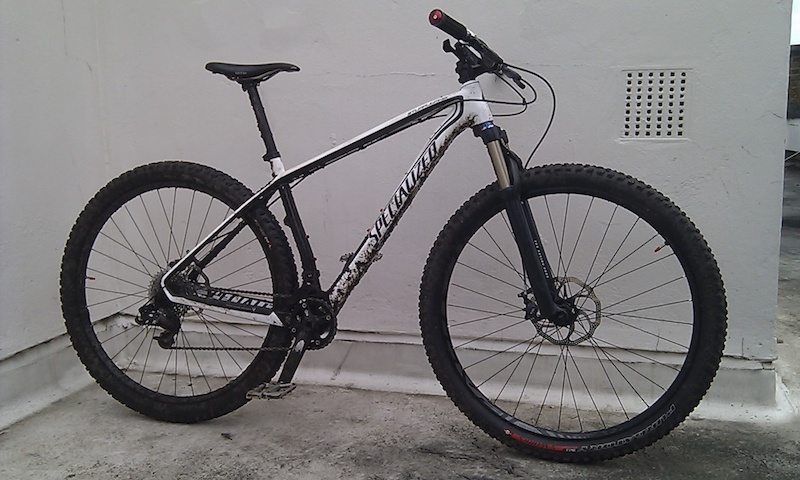
works very nicely for fast trail riding, but could easily be “raced” if necessary probably by swapping the tires and perhaps a dual chainring at the front
eshershoreFree MemberPosted 10 years agothe current solution works fine, unless you have OCD
most current stems using dual clamping bolts have a setting torque of 5nm
this is more than enough to hold the stem secure on the fork steerer during normal use (or even quite extreme use i.e. freeride, dirt jump and downhill!)
but will also prevent damage to the stem or fork steerer if you have a big “off” as the design will allow the energy involved to overcome the bolt torque and rotate the stem on the steerer, rather than snap it!
eshershoreFree MemberPosted 10 years agoevery morning on my 7.30am commute (30 mile round trip) I see a guy hammering through Richmond Park in London on a bright yellow fat bike, always puts a smile on my face and its a highlight of an otherwise dull commute
got me thinking ;)
eshershoreFree MemberPosted 10 years agohave used Hope Pro II hubs for a number of years on my mountain bikes and always experienced this issue to some small degree, despite using the recommend Shimano XT or SRAM PG-990 cassettes with the “spider style” cog carriers, setting the lockring to correct torque and smearing Shimano anti-seize on the splines before mounting the cassette
it was just one of those things, and the hubs worked excellently in every other respect. I’d only remove the cassette once worn out (once a season) so no big deal
when it came to road wheels for my first road build of course I went with Hope hubs, I got the Pro III hubs on Mavic Open Pro rims
I was quite shocked how difficult it was to remove the Shimano 105 cassette after about 7 months of use, this is what I found (you can see where I have cleaned it up with a file):
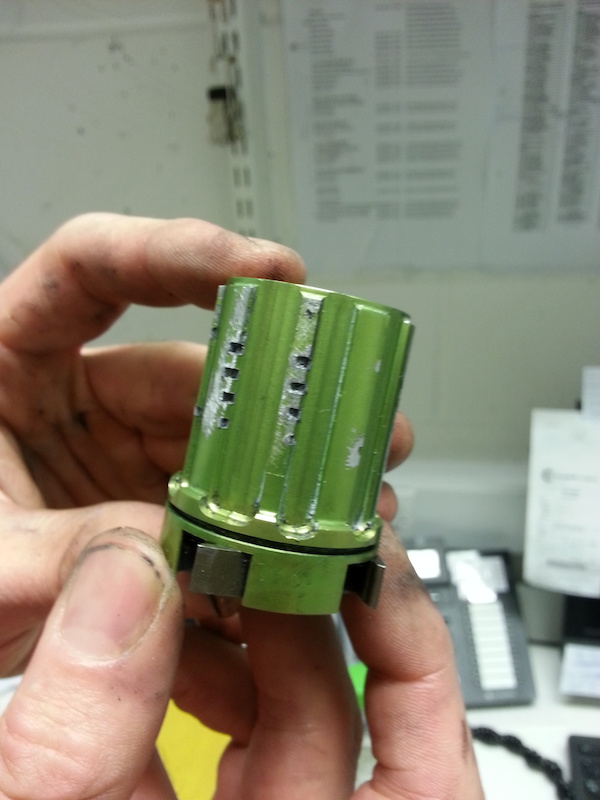
had to remove the cassette using a flat blade screwdriver and hammer to ‘rotate’ the cogs off the body.
returned the body to Hope who replaced it FOC with no questions asked.
I’m not a big guy or a power house on the road bike, more of an an endurance rider who enjoys hill climbs, so it was not a case of abusing the drivetrain with weight or big legs!
would like to see Hope move to using a steel “leading strip” on their bodies which would surely add very little weight, perhaps some extra cost but definitely make their bodies more durable :)
eshershoreFree MemberPosted 10 years agoGood luck!
I ride 250km a week so 1000 km a month commuting to work and back, don’t really ride recreationally any more
Body gets used to the distance quite easily as long as you don’t push too hard, you will get hungry though!
eshershoreFree MemberPosted 10 years agoXtr di2 is definitely coming in 2014 and its almost certain to be 11 speed using the tech from the 11 speed dura ace and ultegra di2 group sets ;)
eshershoreFree MemberPosted 10 years agocan highly recommend the Dr. Jekyll
I had one as a “freeride” play bike when getting back into mountain biking and thoroughly enjoyed it
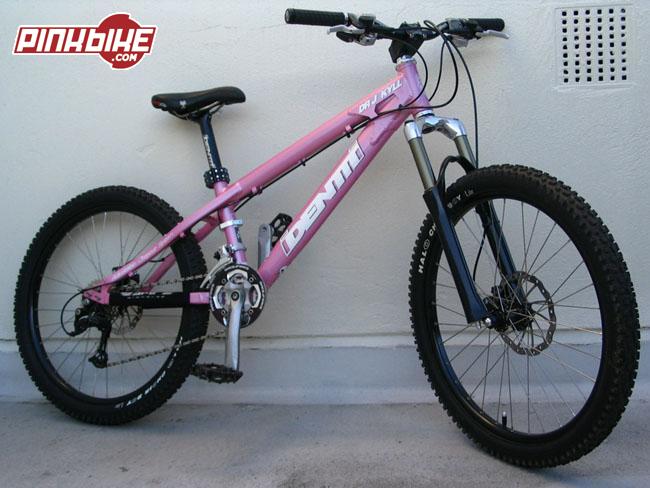
my missus also had one in bright pink, and she loved that bike too :)
eshershoreFree MemberPosted 10 years agoteflon-coated shimano inner cable and SP-41 outer cable with Shimano cable end caps (including the all important aluminium alloy cap at the derailleur end)
use this on all my bikes: road, hybrid and mountain
cannot go wrong really?
eshershoreFree MemberPosted 10 years agoMany 2014 wheels are 11 SPD compatible, but check before buying…
older Zipp wheels were a particular problem in that the wheel had to be rebuilt with the 11 SPD hub, you could not just change the body :(
eshershoreFree MemberPosted 10 years ago£80 is not bad value for 400 L because L&M have very good heritage as a scuba and now bike light manufacturer with solid backup through Madison
its not likely to burn down your house unlike some of the cheap imports!
I had a L&M Seca 200 which needed 1 warranty during its 3 years of life and had it back within 1 week of sending to Madison
eshershoreFree MemberPosted 10 years agogot my first proper mountain bike in 1986, was riding BMX and thought a mountain bike would “fall to bits” but it was surprisingly fun and quite tough
Ridgeback 601LX
not mine in the picture:
 eshershoreFree MemberPosted 10 years ago
eshershoreFree MemberPosted 10 years agoif you use a good quality “bung” you should not have any problems, and it doesn’t require any glue?
eshershoreFree MemberPosted 10 years ago40nm on the cassette lock ring and a good smear of Shimano Anti-Seize on the freehub body before fitting
depending on the cassette design, some will notch even the steel body, some won’t
this was my alloy body on my Pro III (road bike) after 6 months with a 105 cassette

I’ve been selling, maintaining and using Hope hubs for many years, and was familiar with having difficulty removing non-spider and even spider style cassettes on mountain bikes, and using a steel file to clean up any notching before fitting a new cassette, but this level of damage on my Pro III was nothing I had seen before.
I had to remove the cogs using a flat blade screwdriver and hammer to rotate each cog the 2-3mm it had bitten into the alloy body.
I am not a big guy with big legs and only riding in S-East England, so was surprised it was so badly notched.
after talking to Hope Tech, and sending the damaged part back, they replaced it FOC which is typical of Hope with their excellent backup, one reason I will always buy Hope for hubs :)
